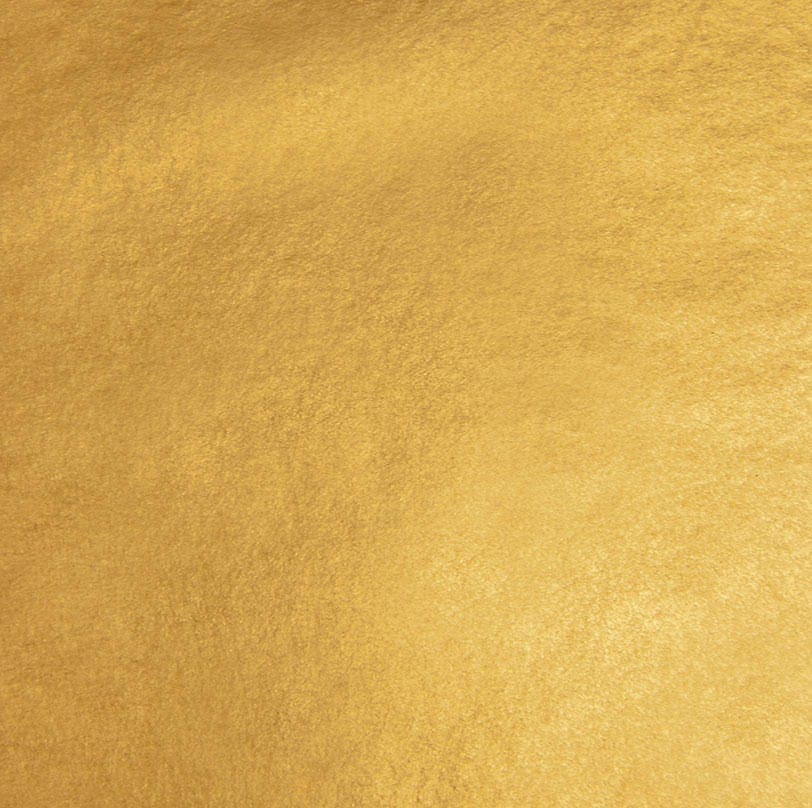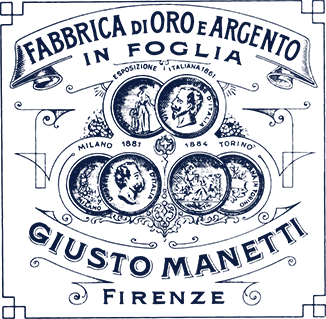Gold Leaf - Frequently asked questions
FaqThe name gold leaf has very ancient origins. The Greeks called it πέταλον, which means leaf, and the Latins bractea, which has the same meaning. In addition to the arboreal metaphor, the choice of this name probably also derives from the fact that gold leaf has always been used as a leaf/sheet for covering statues, walls, room ceilings, furniture and fabrics, that is to wrap objects made of other materials in thin, precious foil.
Gold leaf is used to coat objects made of wood, glass, metal, stone, fabric etc. with a very thin layer of gold. Despite being very thin and almost impalpable, once applied, the gold leaf is resistant and durable. The techniques for creating state-of-the-art gilding are quite complex and laborious, but thanks to our Gilding Academy you can discover every step.
Only gold leaf that contains pure gold can be defined as gold leaf, possibly fused melted with other precious metals such as silver and copper. The various components form an alloy which is poured into moulds, allowed to cool and then progressively thinned. Gold leaves of different carats are available on the market. Gold leaves that do not contain real gold can be silver leaves, platinum leaves, palladium leaves or imitation gold leaves (also called gold-like), which are made with aluminium or copper.
For millennia, gold leaf has represented the desire to give a high aesthetic and symbolic value to an object. Since ancient times the royal palaces were covered with gold leaf; in various religions the statues of the deities are covered with gold leaf; on the tables of rich people, dishes and food were also wrapped in gold leaf. In all its uses, the gold leaf has the dual purpose of attracting attention and emphasizing the special meaning of the objects it covers.
Even if it is very thin and light as a feather, good quality gold leaf applied correctly can last a very long time, as evidenced, for example, by the Egyptian or Roman gilding, well preserved after millennia. This depends both on the purity of the gold and on the environment in which it is found. The gilding technique used is also very important. In ancient times, for example, mercury gilding was allowed; a technique used by Maestro Matteo Manetti in 1602 for the gilding of the golden ball on the Brunelleschi dome.
24kt gold leaf made with pure gold, certified and guaranteed, is not toxic because gold is an inert material and, as such, does not interfere in any way with the body. For this reason, pure gold leaf can not only be used safely for decorating tableware, but it can also be eaten. The gold leaf used for gilding may contain copper which can be toxic in high doses. Even using preparations based on non-pure gold such as colloidal gold can cause reactions that are harmful to human health.
The gold leaf is very thin and very light. Its weight varies according to the dimensions, the alloys used and the thickness required by the surface to be gilded: inlaid surfaces require thinner thicknesses, while flat surfaces require greater thicknesses.
Unlike the authentic gold leaf which is well preserved even outdoors for 30 years or more, imitation gold leaf is more sensitive to atmospheric agents and thermal shocks and is less resistant to oxidation and corrosion. Even if treated with a protective varnish, imitation gold leaf only lasts a few years.
Gilding is a decorative technique whose purpose is to make an artifact precious. Gilding is defined as the process of applying gold leaf to an object made with other materials. Gold Leaf is a very thin sheet of gold that is used to make the gilding. The craftsman who takes care of the gilding is called “gilder”, the one who produces the gold leaf is called “goldbeater”.
Gold leaf is produced using only pure gold, sometimes melted with silver and copper. Imitation gold leaf, also called gold-like, is produced with aluminium or copper. Gold leaf maintains its natural and intense brilliance for a long time because pure gold does not oxidize. Imitation leaf, on the other hand, is not very resistant to oxidation and corrosion. Pure 24 kt gold leaf is non-toxic because gold is an inert material that does not interact with the body. Imitation gold leaf contains copper which can be toxic in high doses.
In the field of architecture and interior design, gold leaf is used to decorate entire buildings, domes, architectural details, gates, shop signs, furniture and surfaces. Gold leaf is also used in home décor for gilding frames, mirrors, ceramic or glass tableware, bathtubs. Gold leaf is also widely used for the restoration of paintings, sculptures, metal objects and antique frames and books. Two particular sectors in which 24kt gold leaf, made following strict legal regulations, is used are cosmetics (for make-up and for exclusive skin care treatments) and haute cuisine (for food decoration).
Gilding is the process of applying gold leaf to an object made with other materials (stone, wood, metal, glass, fabric, etc.). The craftsman who carries out the gilding is called the gilder. There are many gilding techniques: some (such as gouache gilding) are very complex and laborious and are made with traditional methods and materials; other techniques are simpler and faster and do not require special experience. In order to apply the gold leaf, it is necessary to treat the surface so as to make it smooth, then apply glue and spread the gold leaf over it. In some cases, a protective varnish is also applied.
To produce gold leaf, pure gold is melted with other noble metals. The ingot thus obtained passes several times between the rolling cylinders to progressively reduce its thickness. The thin gold foil is then cut into squares as large as stamps which are placed between sheets of paper and subjected to numerous mechanical or manual rolling cycles that "stretches" the foils making the surface perfectly smooth. More information
Once the gold leaf was produced in small artisan shops. Today it is made in modern companies using sophisticated tools. Although most of the production process is mechanized, the finishing step is still carried out entirely by hand by the gold-beating craftsman who uses hammers of different shapes and weights to give the gold leaf a uniform thickness and perfect brightness. The Manetti gold leaf is produced in Florence and is 100% made in Italy.
Gilders can recognize gold leaf at a glance because it has a unique ability to "play with the light" by reflecting it irregularly like no imitation gold leaf can. For those who are not experts, however, it is not easy to distinguish gold leaf from imitation gold leaf. To do so, the same manual (acid) or electronic methods that are used to test the authenticity of gold can be used.
In order to decide which type of gold leaf to buy, it is essential to know what use will be interiors and gold leaves that are particularly resistant to weathering and therefore suitable for outdoors. There are also gold leaves suitable for gilding objects with very irregular surfaces or ideal size leaves for gilding large smooth surfaces. In any case, it is very important to buy gold leaf only from producers such as Manetti, who certify its origin and authenticity and can give useful tips for making the right choice.
Throughout history, gold leaf has always been used as a symbol of economic and social status. Used in exterior and interior architectural projects, gold leaf immediately conveys an idea of opulence that is well suited to the residences of kings as well as to the burials of pharaohs; public buildings including churches, temples and liturgical buildings in general. From classical antiquity to Gothic and Renaissance architecture up to the golden triumph of the Baroque and Art Noveau, all architectural styles have gradually rediscovered and used gold leaf to ennoble buildings, monuments, rooms and valuables. This long tradition is still alive today, as evidenced - for example - by the Prada Foundation in Milan, designed by Rem Koolhaas and completely covered in Manetti gold leaf. See more projects made with gold leaf





